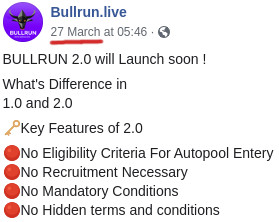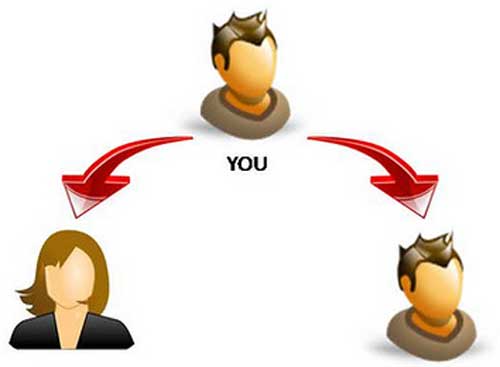
BullRun’s website domain (“bullrun.live”) was privately registered on January 10th, 2020.
At the time of publication, Alexa cites Nigeria (29%), Cote d’Ivoire (21%) and Russia (7%) as top sources of traffic to BullRun’s website.
As always, if an MLM company is not openly upfront about who is running or owns it, think long and hard about joining and/or handing over any money.
BullRun’s Products
BullRun has no retailable products or services, with affiliates only able to market BullRun affiliate membership itself.
BullRun’s Compensation Plan
BullRun affiliates buy matrix cycler positions for 0.1 ETH.
Matrix sizes used by BullRun include 2×1 and 3×1.
A 2×1 matrix is simple in nature, requiring only two positions to be filled:
A 3×1 matrix expands the required number of positions to be filled to three.
Positions in the matrix are filled via direct and indirect recruitment of new BullRun affiliates.
As affiliates are placed in the matrix, commissions are paid out.
Once a matrix is full, the position at the top of the matrix cycles out. At this point profits can be kept or put towards entry into the next cycler tier.
Commission payments across all ten BullRun matrix cycler tiers are as follows:
- Tier 1 (2×1 matrix, positions cost 0.1 ETH) – no commission, cycles into Tier 2
- Tier 2 (3×1 matrix) – 0.1 ETH commission, cycles into Tier 3
- Tier 3 (3×1 matrix) – 0.5 ETH commission, cycles into Tier 4
- Tier 4 (3×1 matrix) – 1 ETH commission, cycles into Tier 5
- Tier 5 (3×1 matrix) – 1 ETH commission, cycles into Tier 6
- Tier 6 (3×1 matrix) – 5 ETH commission, cycles into Tier 7
- Tier 7 (3×1 matrix) – 10 ETH commission, cycles into Tier 8
- Tier 8 (3×1 matrix) – 10 ETH commission, cycles into Tier 9
- Tier 9 (3×1 matrix) – 50 ETH commission, cycles into Tier 10
- Tier 10 (3×1 matrix) – 300 ETH commission
If an affiliate opts to not enter into the next cycler tier, here are their commission payments:
- Tier 1 (positions cost 0.1 ETH) – 0.2 ETH commission kept
- Tier 2 (positions cost 0.2 ETH) – 0.6 ETH commission kept
- Tier 3 (positions cost 0.5 ETH) – 1.5 ETH commission kept
- Tier 4 (positions cost 1 ETH) – 3 ETH commission kept
- Tier 5 (positions cost 2 ETH) – 6 ETH commission kept
- Tier 6 (positions cost 5 ETH) – 15 ETH commission kept
- Tier 7 (positions cost 10 ETH) – 30 ETH commission kept
- Tier 8 (positions cost 20 ETH) – 60 ETH commission kept
- Tier 9 (positions cost 50 ETH) – 150 ETH commission kept
- Tier 10 (positions cost 100 ETH) – 300 ETH commission kept
Referral Commissions
BullRun pays referral commissions via a unilevel compensation structure.
A unilevel compensation structure places an affiliate at the top of a unilevel team, with every personally recruited affiliate placed directly under them (level 1):
If any level 1 affiliates recruit new affiliates, they are placed on level 2 of the original affiliate’s unilevel team.
If any level 2 affiliates recruit new affiliates, they are placed on level 3 and so on and so forth down a theoretical infinite number of levels.
BullRun caps payable unilevel team levels at one hundred.
Recruitment commissions are paid across these hundred levels as follows:
- level 1 (personally recruited affiliates) – 0.01 ETH
- level 2 – 0.005 ETH
- level 3 – 0.00025 ETH
- levels 4 to 100 – 0.0025 ETH
Joining BullRun
BullRun affiliate membership is tied to the purchase of at least one 0.1 ETH cycler position.
Conclusion
BullRun pitches itself as a “Super fast way to make 300+ ETH”.
The problem is this is achieved via investment fraud, making BullRun a scam.
In attempt to address this, on their website BullRun claims “scam (is) impossible”.
The aim of smart contracts is to provide security. a computerized transaction protocol that executes the terms of a contract.
It is impossible to change the algorithm or delete the contract.
Hence its UNSTOPPABLBLE & SCAM FREE
BullRun is a Ponzi scheme because newly invested funds are used to pay existing investors.
Whether a Ponzi cycler is run off a regular script or a cryptocurrency script, it’s still investment fraud. That, by definition, makes BullRun a scam.

In Ponzi schemes the primary benefactors are those running them and those who get in early.
In a matrix cycler, the admin typically makes the most money by way of preloaded admin positions.
These positions are generated at no cost and are first to cycle into the upper tiers, where most of the money is passed upline.
Top recruiters get what’s left, with the majority of investors losing out when the scheme inevitably collapses.

